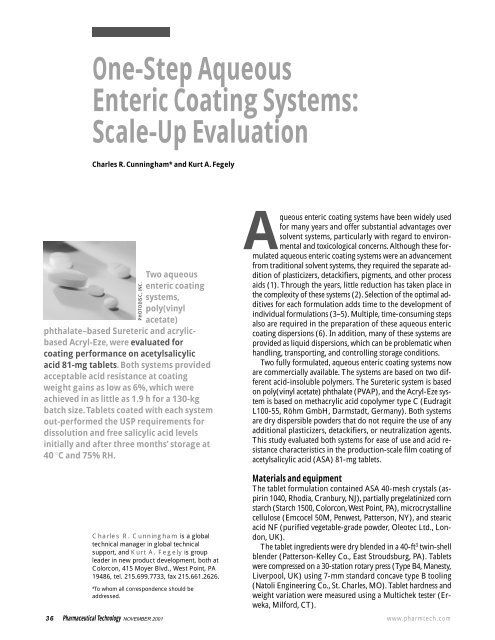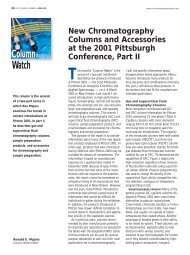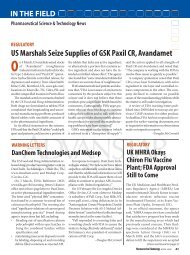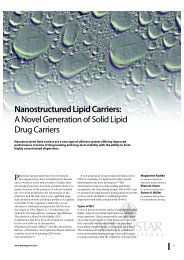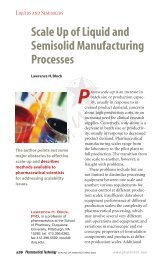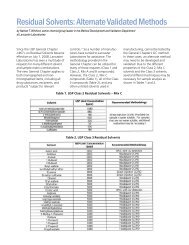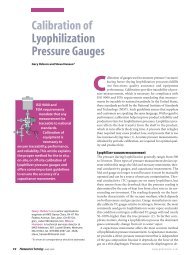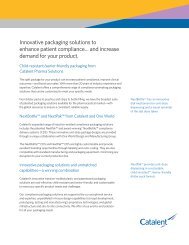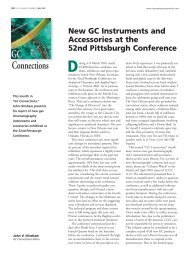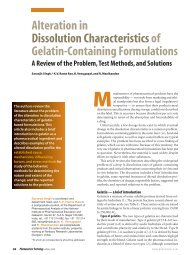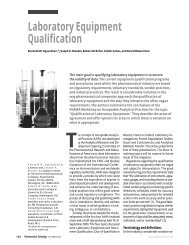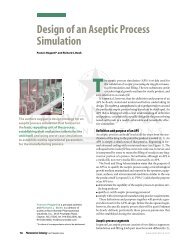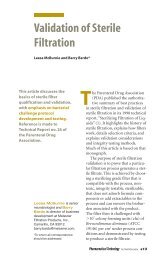One-Step Aqueous Enteric Coating Systems - Pharmaceutical ...
One-Step Aqueous Enteric Coating Systems - Pharmaceutical ...
One-Step Aqueous Enteric Coating Systems - Pharmaceutical ...
Create successful ePaper yourself
Turn your PDF publications into a flip-book with our unique Google optimized e-Paper software.
<strong>One</strong>-<strong>Step</strong> <strong>Aqueous</strong><br />
<strong>Enteric</strong> <strong>Coating</strong> <strong>Systems</strong>:<br />
Scale-Up Evaluation<br />
Charles R. Cunningham* and Kurt A. Fegely<br />
Two aqueous<br />
enteric coating<br />
systems,<br />
poly(vinyl<br />
acetate)<br />
phthalate–based Sureteric and acrylicbased<br />
Acryl-Eze, were evaluated for<br />
coating performance on acetylsalicylic<br />
acid 81-mg tablets. Both systems provided<br />
acceptable acid resistance at coating<br />
weight gains as low as 6%, which were<br />
achieved in as little as 1.9 h for a 130-kg<br />
batch size. Tablets coated with each system<br />
out-performed the USP requirements for<br />
dissolution and free salicylic acid levels<br />
initially and after three months’ storage at<br />
40 C and 75% RH.<br />
PHOTODISC, INC.<br />
<strong>Aqueous</strong> enteric coating systems have been widely used<br />
for many years and offer substantial advantages over<br />
solvent systems, particularly with regard to environmental<br />
and toxicological concerns. Although these formulated<br />
aqueous enteric coating systems were an advancement<br />
from traditional solvent systems, they required the separate addition<br />
of plasticizers, detackifiers, pigments, and other process<br />
aids (1). Through the years, little reduction has taken place in<br />
the complexity of these systems (2). Selection of the optimal additives<br />
for each formulation adds time to the development of<br />
individual formulations (3–5). Multiple, time-consuming steps<br />
also are required in the preparation of these aqueous enteric<br />
coating dispersions (6). In addition, many of these systems are<br />
provided as liquid dispersions, which can be problematic when<br />
handling, transporting, and controlling storage conditions.<br />
Two fully formulated, aqueous enteric coating systems now<br />
are commercially available. The systems are based on two different<br />
acid-insoluble polymers. The Sureteric system is based<br />
on poly(vinyl acetate) phthalate (PVAP), and the Acryl-Eze system<br />
is based on methacrylic acid copolymer type C (Eudragit<br />
L100-55, Röhm GmbH, Darmstadt, Germany). Both systems<br />
are dry dispersible powders that do not require the use of any<br />
additional plasticizers, detackifiers, or neutralization agents.<br />
This study evaluated both systems for ease of use and acid resistance<br />
characteristics in the production-scale film coating of<br />
acetylsalicylic acid (ASA) 81-mg tablets.<br />
Charles R. Cunningham is a global<br />
technical manager in global technical<br />
support, and Kurt A. Fegely is group<br />
leader in new product development, both at<br />
Colorcon, 415 Moyer Blvd., West Point, PA<br />
19486, tel. 215.699.7733, fax 215.661.2626.<br />
*To whom all correspondence should be<br />
addressed.<br />
Materials and equipment<br />
The tablet formulation contained ASA 40-mesh crystals (aspirin<br />
1040, Rhodia, Cranbury, NJ), partially pregelatinized corn<br />
starch (Starch 1500, Colorcon, West Point, PA), microcrystalline<br />
cellulose (Emcocel 50M, Penwest, Patterson, NY), and stearic<br />
acid NF (purified vegetable-grade powder, Oleotec Ltd., London,<br />
UK).<br />
The tablet ingredients were dry blended in a 40-ft 3 twin-shell<br />
blender (Patterson-Kelley Co., East Stroudsburg, PA). Tablets<br />
were compressed on a 30-station rotary press (Type B4, Manesty,<br />
Liverpool, UK) using 7-mm standard concave type B tooling<br />
(Natoli Engineering Co., St. Charles, MO). Tablet hardness and<br />
weight variation were measured using a Multichek tester (Erweka,<br />
Milford, CT).<br />
36 <strong>Pharmaceutical</strong> Technology NOVEMBER 2001 www.pharmtech.com
Table I: Composition of the coating dispersions.<br />
PVAP System<br />
Acrylic System<br />
Component % Weight (kg) % Weight (kg)<br />
<strong>Coating</strong> solids 15.00 13.00 20.00 13.00<br />
Deionized water 85.00 73.67 80.00 52.00<br />
Total 100.00 86.67 100.00 65.00*<br />
* 65.0 g of antifoam emulsion was added to the water before the acrylic powder.<br />
Table II: Uncoated ASA 81-mg tablet properties.<br />
Test Average Standard Deviation<br />
Weight (mg) n 20 170.16 0.67<br />
Breaking force (kp) n 20 10.70 0.30<br />
Friability (%) 20 tablets 0.12 —<br />
Disintegration time<br />
in water (min) n 6 3.20 0.40<br />
Table III: Mixing time comparison (in minutes).<br />
Mixing <strong>Step</strong> PVAP System Acrylic System<br />
Antifoam addition — 0.5<br />
<strong>Enteric</strong> powder addition 5.0 5.0<br />
Mixing before coating 30.0 20.0<br />
Filtration through screen 5.0 5.0<br />
Total dispersion preparation time 40.0 30.5<br />
Table IV: <strong>Coating</strong> process conditions.<br />
Process Parameter PVAP-Based Acrylic-Based<br />
Average inlet temperature (C) 69.85 52.70<br />
Average exhaust temperature (C) 48.44 36.24<br />
Average tablet-bed temperature (C) 39.76 30.00<br />
Average spray rate (g/min) 380.52 343.00<br />
Atomizing air pressure (bar) 3.00 3.00<br />
Fan air pressure (bar) 2.50 2.50<br />
Pan speed (rpm) 7.00 7.00<br />
Airflow (m 3 /h) 2600.00 2600.00<br />
Total spray time (min) 227.76 189.50<br />
The coating materials used were the PVAP-based white aqueous<br />
enteric coating system (Sureteric) and the methacrylic acid<br />
copolymer (acrylic) –based pigmented aqueous enteric film<br />
coating system (Acryl-Eze), both manufactured by Colorcon.<br />
An antifoaming agent (30% simethicone emulsion USP, Dow<br />
Chemical Co., Midland, MI) was used in the preparation of the<br />
acrylic-based system.<br />
The PVAP-based dispersion was prepared using a model RW<br />
28 DX mixer (IKA Labortechnik, Staufen, Germany). A model<br />
AX3 mixer (Silverson Machines Ltd., Chesham Bucks, UK) was<br />
used to prepare the acrylic-based dispersion. Early mixing guidelines<br />
for the acrylic-based product recommended the use of a<br />
high-shear mixer such as the AX3. Subsequent technical literature<br />
indicates that either high- or low-shear mixing can be used<br />
for preparing the coating dispersion (7).<br />
A side-vented 48-in. coating pan (Accelacota 150, Manesty,<br />
Liverpool, UK) was used to apply the coatings. Acid uptake testing<br />
was performed using a disintegration-testing apparatus<br />
(model ZT54, Erweka, Milford, CT). An<br />
automated dissolution test station (VK-<br />
7010, apparatus I, VanKel, Cary, NC) with<br />
a UV spectrophotometer (Varian, Palo Alto,<br />
CA) was used for drug-release testing. An<br />
HPLC system (Alliance 2690, Waters Corp.,<br />
Milford, MA) was used for free salicylic<br />
acid determinations.<br />
The packaging materials used for stability<br />
testing of the coated tablets were 85-cm 3 foil sealable<br />
HDPE bottles (Drug Plastics and Glass Co., Boyertown,<br />
PA) and desiccant packs (3964, Süd-Chemie<br />
Performance Packaging, Belen, NM).<br />
Methods<br />
Blending and tablet preparation. ASA, microcrystalline<br />
cellulose, partially pregelatinized starch, and stearic<br />
acid were blended for 20 min in the twin-shell blender.<br />
The batch size was 560 kg.<br />
The blend was compressed to a target tablet weight<br />
of 170 mg, and the compaction force was adjusted to<br />
produce tablets with a breaking force of 8 kp and<br />
0.25% friability. Press speed was 42 rpm for a production<br />
rate of 75,600 tablets/h.<br />
Preparation of the coating dispersions. <strong>Coating</strong> dispersions<br />
were prepared by adding the dry aqueous enteric<br />
coating formulations directly into a mixing tank<br />
filled with deionized water (ambient ~20 C). Mixer<br />
speed was controlled to produce and maintain a deep<br />
center liquid vortex into which the powder was added.<br />
For the acrylic-based system, antifoam was added to<br />
the water just before the addition of the powder to reduce<br />
foam generated during the initial high-speed mixing.<br />
Immediately after the addition of the powder to<br />
the water, the mixer speeds were reduced to maintain<br />
gentle stirring. This was done for both coating polymer<br />
systems. The coating systems were dispersed at<br />
the solids concentration recommended by the manufacturer.<br />
A sufficient amount of each coating dispersion<br />
was prepared to apply a theoretical 10% weight gain of<br />
coating to the tablets (see Table I). Each of the dispersions was<br />
screened through a 250-m sieve before coating.<br />
Spray coating. Tablet coating was carried out in the 48-in. sidevented<br />
pan equipped with four spray guns. The coating dispersions<br />
were delivered to the spray guns through individual tubes<br />
fed from a peristaltic pump. The pan load of ASA 81-mg tablets<br />
was 130 kg. The coating process controls were set using the parameters<br />
recommended by the manufacturer for the enteric coating<br />
systems. Samples of tablets for performance testing were removed<br />
from the coating pan at increments from 5–10%<br />
theoretical coating weight gain. Process data were recorded<br />
throughout the trials.<br />
Acid uptake testing. A variation of the gastro-resistant tablet<br />
disintegration method (European Pharmacopoeia Third Edition<br />
2001) was used. In this revised method, six coated tablets were<br />
weighed individually and placed in the disintegration basket<br />
tubes. We immersed the disintegration basket in 900 mL of<br />
38 <strong>Pharmaceutical</strong> Technology NOVEMBER 2001 www.pharmtech.com
0.1 N hydrochloric acid and operated the apparatus for 2 h. The<br />
individual tablets that were still intact then were dried with a<br />
towel and reweighed. The percent of weight increase was reported<br />
as % acid uptake. Tablets that fully disintegrated during<br />
the testing were counted as having 100% acid uptake. This<br />
method has been reported to provide an accurate measure of<br />
acid resistance of the coating, and acid uptake values 5% suggest<br />
that the tablets would readily pass the acid phase of the<br />
delayed-release dissolution testing (8).<br />
Dissolution and free salicylic acid testing. The dissolution and<br />
free salicylic acid tests for the coated tablets were performed according<br />
to the USP 24 monograph for delayed-release ASA tablets.<br />
Packaging and stability. Two sets of coated tablets from each<br />
trial were packaged in high-density polyethylene (HDPE) bottles<br />
(120 tablets/bottle). <strong>One</strong> set was packaged with desiccant<br />
and the other without. All bottles were induction (foil) –sealed<br />
and placed in a chamber for three months at 40 C and 75% RH.<br />
Results and discussion<br />
Uncoated aspirin tablets. Tablets used in a functional coating<br />
process must be sufficiently robust to withstand mechanical<br />
stresses and to exhibit very low potential for erosion and edge<br />
chipping. Any defects in the tablet core may result in a localized<br />
weakness of the functional film. A subcoating process may<br />
be used to strengthen friable cores before the application of the<br />
Table V: Dissolution results.<br />
PVAP System<br />
Acrylic System<br />
% Released in t 80%<br />
in % Released in t 80%<br />
in<br />
Theoretical 0.1 N HCL Phosphate Buffer 0.1 N HCL Phosphate Buffer<br />
Weight Gain (%) after 2 h (pH 6.8) after 2 h (pH 6.8)<br />
6 0.0 30 min 0.0 30 min<br />
7 0.0 30 min 0.0 30 min<br />
8 0.0 30 min 0.0 30 min<br />
9 0.0 30 min 0.0 30 min<br />
10 0.0 30 min 0.0 30 min<br />
Table VI: Dissolution stability.<br />
PVAP System<br />
Acrylic System<br />
% Released in t 80%<br />
in % Released in t 80%<br />
in<br />
Theoretical 0.1 N HCL Phosphate Buffer 0.1 N HCL Phosphate Buffer<br />
Weight Gain (%) after 2 h (pH 6.8) after 2 h (pH 6.8)<br />
Packaged without Desiccant<br />
6 25 not tested 0.0 30 min<br />
7 0.5 30 min 1.0 30 min<br />
8 0.5 30 min 0.0 30 min<br />
9 5.3 30 min 0.0 30 min<br />
10 4.9 30 min 0.0 30 min<br />
Packaged with Desiccant<br />
6 1.6 30 min 0.0 30 min<br />
7 0.7 30 min 0.0 30 min<br />
8 0.7 30 min 0.0 30 min<br />
9 0.7 30 min 0.0 30 min<br />
10 2.1 30 min 0.0 30 min<br />
functional coat but is not desirable in terms of process time and<br />
complexity. Subcoats also may be necessary to prevent interaction<br />
between the drug substance and the coating formulation<br />
ingredients. Interactions between the ASA and either of<br />
the enteric coating systems in this study were not expected. In<br />
this study, the ASA 81-mg tablets were sufficiently robust to<br />
avoid the use of a subcoat step (See Table II).<br />
Dispersion mixing time.Because both polymer systems are fully<br />
formulated, the mixing process consisted of a simple addition<br />
of the powder formulations to the water. The total preparation<br />
time was very short for both systems (see Table III).<br />
Filtration of the material before coating<br />
was performed to ensure that no undispersed<br />
particles of polymer remained that<br />
could result in gun blockages.<br />
<strong>Coating</strong> process. The coating process for<br />
each trial was conducted using the recommended<br />
coating conditions for each coating<br />
system (9,10). The gun-to-bed distance<br />
was 24 cm, and the distance between guns<br />
was 18 cm. The spray applications were<br />
continuous from start to finish, and spray<br />
rates were held constant throughout the<br />
coating trials. The coating data are listed in<br />
Table IV. The acrylic-based system required<br />
a lower tablet-bed temperature than did the<br />
PVAP system, and the spray rate for the<br />
acrylic-based system was slightly lower. The<br />
total coating time for the acrylic-based system<br />
was shorter because of the higher solids<br />
concentration of the dispersion. The tablets<br />
were not dried further after the application<br />
of the coatings other than during a cooldown<br />
period in the pan before unloading.<br />
<strong>Coating</strong> process efficiency for both systems<br />
was 90% on the basis of the calculation<br />
of tablet-weight difference before and after<br />
coating.<br />
The coating process for both systems was<br />
free of any problems. The coated tablets<br />
had no obvious defects or signs of sticking<br />
or tackiness (see Figure 1).<br />
Acid resistance testing. Samples of the<br />
40 <strong>Pharmaceutical</strong> Technology NOVEMBER 2001 www.pharmtech.com<br />
(a)<br />
(b)<br />
Figure 1: Photographs of coated tablets (theoretical 10% weight gain).<br />
Tablets are coated with (a) the acrylic-based system and (b) the PVAPbased<br />
system.
% Acid uptake<br />
37.5<br />
35.0<br />
32.5<br />
30.0<br />
27.5<br />
25.0<br />
22.5<br />
20.0<br />
17.5<br />
15.0<br />
12.5<br />
10.0<br />
7.5<br />
5.0<br />
2.5<br />
0.0<br />
5 6 7 8 9 10<br />
% <strong>Enteric</strong> coating theoretical weight gain<br />
Figure 2: Acid uptake comparison.<br />
% Acid uptake<br />
40<br />
35<br />
30<br />
25<br />
20<br />
15<br />
10<br />
5<br />
% Free salicylic acid<br />
3.0<br />
2.5<br />
2.0<br />
1.5<br />
1.0<br />
0.5<br />
0.0<br />
% Theoretical coating level 6 7 8 9 10<br />
PVAP-based 0.77 0.95 1.18 1.03 0.80<br />
Acrylic-based 1.71 2.00 2.04 2.16 2.08<br />
PVAP-based with desiccant 0.53 0.38 0.44 0.43 0.97<br />
Acrylic-based with desiccant 0.44 0.44 0.45 0.43 0.46<br />
Figure 4: Free salicylic acid stability.<br />
PVAP-based<br />
Acrylic-based<br />
PVAP-based<br />
Acrylic-based<br />
0<br />
1.5 1.8 2.0 2.3 2.5 2.8 3.0 3.3 3.5 3.8<br />
Total coating time (h)<br />
Figure 3: Acid-resistance testing versus coating process time.<br />
tablets that were taken throughout the coating process were subjected<br />
to acid uptake testing as a measure of the necessary level<br />
of coating that would provide acceptable acid resistance. At 5%<br />
theoretical weight gain, the PVAP system exhibited less acid uptake<br />
than did the acrylic system, although both samples were<br />
well above the desired level of 5% acid uptake. Samples taken<br />
at weight gains of 6% and above all had acid uptake values of<br />
4%. At 6% weight gain, the differences in acid uptake between<br />
the PVAP- and the acrylic-based systems did not exceed<br />
0.63% (see Figure 2).<br />
Of concern in any coating process is the actual production<br />
time required to coat the tablets. As a batch operation, film<br />
coating is often a bottleneck in the manufacturing process.<br />
Long coating times are common for functional coatings because<br />
of the high amount of coating that must be applied as<br />
well as the need to ensure acid resistance. In the case of each<br />
enteric coating system tested in this study, the high solids concentrations<br />
and high spray rates enabled acceptable acid resistance<br />
in a relatively short time. The coating time needed to<br />
reach an acceptable level of acid resistance was 1.9 h for the<br />
acrylic-based system and 2.3 h for the PVAP-based system<br />
(see Figure 3). Dissolution testing confirmed that each system<br />
outperformed the USP requirements of 10% of ASA released<br />
in acid after 2 h and 80% released in pH 6.8 phosphate buffer<br />
within 90 min (see Table V).<br />
The USP limit for free salicylic acid in coated ASA tablets is<br />
3.0%. It is critical to confirm that the humidity conditions<br />
and elevated temperatures in the coating process have not contributed<br />
to the degradation of the ASA. Samples taken from<br />
each trial at 6% and 10% (theoretical) weight gain had free salicylic<br />
acid levels of 0.16%.<br />
Coated-tablet stability. Dissolution and free salicylic acid content<br />
testing was conducted on the coated tablet samples after<br />
three months of storage at 40 C and 75% RH. The tablets were<br />
packaged both with and without desiccant packs as is seen in<br />
commercially available ASA products. The dissolution test results<br />
for the acrylic-coated tablet samples were virtually unchanged<br />
from the initial time point and passed USP delayedrelease<br />
requirements. The tablet samples coated with<br />
the PVAP-based system also passed the USP requirements<br />
except for the 6% weight gain sample with no<br />
desiccant in the package. The percent of ASA released<br />
in the acid phase was slightly higher overall with<br />
the PVAP system–coated tablets but still well within<br />
the USP specification of 10% release (see Table VI).<br />
All tablet samples coated with either enteric coating<br />
system passed the requirements of 3% free salicylic<br />
acid. For the samples packaged without desiccant<br />
packages, the acrylic-based system had slightly<br />
higher free salicylic acid values. The addition of the<br />
desiccant packages resulted in lower free salicylic acid<br />
values (see Figure 4). Differences in the coating<br />
process conditions may explain the variation in free<br />
salicylic acid levels between the acrylic- and PVAPbased<br />
systems. Because acrylic-based systems coat at<br />
lower process temperatures, care must be taken to<br />
ensure that moisture is not absorbed by the tablet<br />
core during the coating process.<br />
Conclusion<br />
Optimum levels of enteric coating for the ASA 81-mg tablet<br />
were determined. Both fully formulated enteric coating systems,<br />
42 <strong>Pharmaceutical</strong> Technology NOVEMBER 2001 www.pharmtech.com
ased on two different polymers, were comparable in overall<br />
process and acid resistance. Although traditional aqueous enteric<br />
coating systems can require multiple component mixing<br />
steps before coating, these systems were dispersed in one step<br />
in a minimum amount of time. Each system provided acceptable<br />
acid resistance to the ASA tablets at low weight gains and<br />
high application rates. The acrylic-based system offers the additional<br />
advantage of being fully pigmented, eliminating the<br />
need for an additional color application if a colored tablet is<br />
desired. Both systems also provided good stability in adverse<br />
storage conditions in this moisture-sensitive application.<br />
Acknowledgments<br />
The authors gratefully acknowledge James Taylor and Scott<br />
McBain of Colorcon for their help in the manufacture and coating<br />
of the ASA tablets. In addition, we thank David Ferrizzi,<br />
Laura Scattergood, and Buffy Young of Colorcon for their analytical<br />
support.<br />
Circle/eINFO 34<br />
References<br />
1. K. Lehmann, “The Application and Processing of Acrylic <strong>Coating</strong>s in<br />
the Form of <strong>Aqueous</strong> Dispersions Compared with Organic Solutions,”<br />
Acta Pharm. Fenn. 91, 225–238 (1982).<br />
2. C. Signorino, “<strong>Aqueous</strong> <strong>Enteric</strong> <strong>Coating</strong>,” Pharm. Technol. Tableting &<br />
Granulation Yearbook 25–26 (1999).<br />
3. N.A. Muhammad et al.,“Modifying the Release Properties of Eudragit<br />
L30D,” Drug Dev. Ind. Pharm. 17 (18), 2497–2509 (1991).<br />
4. R. Bianchini, M. Resciniti, and C. Vecchio, “Technological Evaluation<br />
of <strong>Aqueous</strong> <strong>Enteric</strong> <strong>Coating</strong> <strong>Systems</strong> with and without Insoluble Additives,”<br />
Drug Dev. Ind. Pharm. 17 (13), 1779–1794 (1991).<br />
5. H. Erdmann et al.,“Suitability of Additives to Reduce the Tack of Kollicoat<br />
<strong>Coating</strong>s,” in Proceedings of International Symposium of Controlled<br />
Release Bioactive Material (Controlled Release Society, Minneapolis,<br />
MN), 27 (2000).<br />
6. C. Dangel et al., “<strong>Aqueous</strong> <strong>Enteric</strong> <strong>Coating</strong>s with Methacrylic Acid<br />
Copolymer Type C on Basic and Acidic Drugs in Tablets and Pellets,<br />
Part 1: Acetylsalicylic Acid Tablets and Crystals,” Pharm. Technol. 24<br />
(3), 64–70 (2000).<br />
7. “Acryl-Eze Preparation and Use Guidelines,” technical information,<br />
Colorcon Limited, West Point, PA.<br />
8. M.P. Jordan, J. Taylor, and P.J. Hadfield, “A Comparison of the Performance<br />
Characteristics of <strong>Enteric</strong> Film <strong>Coating</strong> <strong>Systems</strong>,” contributed<br />
paper presented at AAPS National Meeting, New Orleans, LA, October<br />
(1999).<br />
9. “<strong>Coating</strong> Aspirin with Sureteric in a 48-in. Accela-Cota,” technical information,<br />
Colorcon, West Point, PA.<br />
10. “Acryl-Eze <strong>Coating</strong> Parameters,” technical information, Colorcon,<br />
West Point, PA. PT<br />
Circle/eINFO 35<br />
44 <strong>Pharmaceutical</strong> Technology NOVEMBER 2001 www.pharmtech.com


